The White Oak River area is located in Carteret, Jones,
and Onslow Counties, and offers some of the finest black-water
fishing in North Carolina. This area is close to Maysville
(named for the May family) and Swansboro, and is easily
accessible using Haywood Landing as a starting point.
Haywood Landing is just north from Swansboro.
Swansboro's history began around 1730, when the first permanent
settlement was established on the former site of an Algonquin
Indian village at the mouth of the White Oak River. In 1783,
the colonial port town of Swannsborough was incorporated in
honor of Samuel Swann, former speaker of the North Carolina
House of Commons.
The bustling port of Swansboro thrived, and shipbuilding
became its major industry. The town's most famous ship
builder was Captain Otway Burns, builder of the Prometheus,
the first steamboat constructed in North Carolina. Captain
Burns' earlier exploits as the commander of the privateer vessel,
the Snapdragon, had already brought much honor to the town.
The port continued to prosper until the end of the Civil War.
The decline of the shipping industry initiated considerable
growth of lumber and naval stores, which succumbed to the
Great Depression in the 1920s. The town's people then turned
to another natural resource, the sea, and the development of
the commercial fishing industry thrives today along with tourism.
The White Oak River offers some of the finest black water bass
fishing in North Carolina. It also serves as the gateway to
exciting saltwater fishing hotspots such as the lower White Oak
River, Bogue Sound, and nearby Atlantic Ocean, where it is common
to catch bluefish, trout, flounder and Spanish mackerel.
Largemouth bass, pickerel, gar, bowfin, catfish, numerous sunfish,
and when the tides are right, flounder, spot, croaker, puppy drum,
striped bass and speckled trout are abundant throughout the river
system and easily taken on fly, especially top water deer hair flies.
The White Oak River Basin contains some of the most biologically
significant habitats along the eastern Atlantic Coast, including
longleaf pine, pocosin (a peat bog), lime sinks, freshwater tidal
marsh and swamp, tidal red cedar forest, and extensive marsh
and tidal creeks. This is one of my most favorite places to
fish on my days off.
I left Pamlico County at 5 am. The sky was clear and you could
see all the stars. I always look for Orion's Belt, the three
stars in a line in the southeast sky. You could make out the
little and big dippers and the other constellations. The air
was clear and dry. My thoughts lingered to a beautiful day
on the White Oak. I couldn't wait and I couldn't get to Lee's
house fast enough. I traveled through the back roads of New
Bern to Havelock and then down Church Road to Lake Road which
turns into Nine Mile Road ending at the junction of Route 24.
By 6 am I crossed Route 58 which leads to Emerald Isle and the
beaches on the other side of the Inter-coastal Waterway.
Less than a mile on the left, I turned into Megan's Way and
two streets away from my first destination. We were taking
Lee's boat and he had everything ready. Coolers were filled
with ice...sandwiches and soft drinks were packed for lunch.
You can always count on Lee to have some choice cigars too ~~
he always catches fish when he lights one up. Invariably he
will say, "got to light up or we won't catch any fish." Don't
knock it, we have never gotten skunked!
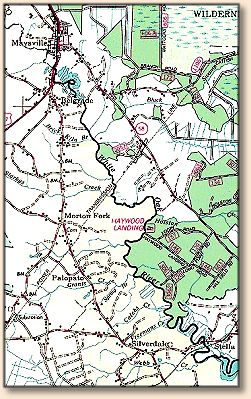
Lee and I launched the boat at Haywood Landing. We headed
north to Holston Creek, the first large creek on the right
as you travel up the White Oak River. Lower portions of
this creek are accessible by boat, but it narrows very
quickly.
Hunter Creek, by comparison, is the first large creek on the
left downstream. At this point, the river is quite large and
bordered by a mix of maritime forest and grass beds, which
makes identifying landmarks difficult. Channel signing is
present, but can be unreliable.
Lee's boat is powered by a Yamaha 4 stroke. Man is that engine
quiet. With no trolling motor we just got upstream of the
tide and floated down along the shore. We fished the west
side of the river first and cast our deer hair flies to the
grass line. Not ten minutes after Lee started puffing on
a Romeo and Juliet and his fly was pounced on by a striped bass.
In his excitement, Lee pulled the fly right out of his mouth.
This happened four more times and I finally said, "Lee, let
him eat the fly."
The fishing action was tremendous but we were having trouble
hooking the fish. Finally it dawned on me that we should try
some smaller hooks and see what it was that found our flies
so irresistible. Finally on the big bend in the river a
fish buried Lee's fly. A small large mouth bass had eaten
the fly, tearing all the hair and half of the flash material.
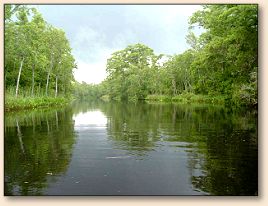 Sure had the right fly. Only trouble was we didn't have
more than 6 of these flies in the box. We moved up the
river to Starky's Creek to see if there were any larger
fish hanging out near the mouth. Lee positioned the boat.
I let out a nice cast under some low hanging branches and
the first strike was a 2 pound large mouth bass. Not
three minutes later Lee landed one. We stayed in that
general location for about two hours, each of us catching
and releasing more than 30 large mouth bass. All caught
on the same flies. This was great fun. Large mouth bass
pull hard and do a lot of tail walking, head shaking and
running before you ever get them to the boat.
Sure had the right fly. Only trouble was we didn't have
more than 6 of these flies in the box. We moved up the
river to Starky's Creek to see if there were any larger
fish hanging out near the mouth. Lee positioned the boat.
I let out a nice cast under some low hanging branches and
the first strike was a 2 pound large mouth bass. Not
three minutes later Lee landed one. We stayed in that
general location for about two hours, each of us catching
and releasing more than 30 large mouth bass. All caught
on the same flies. This was great fun. Large mouth bass
pull hard and do a lot of tail walking, head shaking and
running before you ever get them to the boat.
About the time we arrived at Starkey's Creek the sky
started to get dark. "Is it supposed to rain today?"
I asked Lee.
"No...just be overcast," he replied.
"Sure is getting cool. Are you sure it isn't supposed to rain?"
Except for the obvious grayness, this spot would have made a
nice postcard. The banks were full of grass with deep cuts
next to the reeds. You could see pushes from large bass and
once in awhile you could see what looked like large gar. Moving
down the creek we found an interesting spot where the creek
widened near another feeder creek. It looked really fishy.
Lee lit up another cigar and wouldn't you know it, second cast
he lands a 4 pound bass. I landed two bass in a row and then
my fly was consumed by what I was hoping was a huge bass.
The 5 wt rod bent in half and the pulsating movement of this
fish was taking line but not jumping. It raced back towards
the boat and when it ever rolled on the surface, I almost wet
my pants.
It was the biggest bowfin (dogfish or cypress trout) I had ever
seen. Bowfin are primitive freshwater fish with a light covering
of rounded, overlapping scales, a large mouth, and sharp teeth.
Its swim bladder is capable of functioning as a lung, and the
bowfin can survive out of water for a day. Bowfins are also
called freshwater dogfish; they are voracious and destructive
feeders on fish and invertebrates and are sometimes cannibalistic.
The first bowfin I ever caught was in Florida while fishing with
Sterling Marlin on a photo shoot for the TNN program "On the Pole"
with Lon MacEachern.
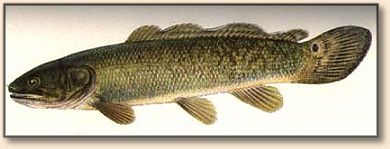
Bowfin give you a great fight. I wasn't disappointed, although
I thought this could be a record large mouth bass. Once I
realized what was on my fly, I turned to Lee. "Where's the net?"
"I don't have one!"
"What about your Bogga Grip?"
"Nope, not in the boat."
Well I wasn't going to stick my thumb in his mouth. Bowfin
have a mouthful of teeth and it isn't a place you want to
be sticking your fingers. So I pulled my pliers out and
that's what we used to lift him for a picture. The bowfin
was not happy and wiggled so much that I thought for sure
I'd be on my way to the doctors. We managed a picture, which
also got me a citation award from the State of North Carolina.
This fish was so strong that he bent my Gamakatsu hook in
three places. I couldn't even get it bent back with the pliers.
The bowfin measured 28 inches, weighing 8 pounds.

After the exhaustion of catching the bass and then the
bowfin, we took a break for lunch. Get this, Lee brought
bread and made sandwiches right there on the water. Man,
I felt like a king. We had a terrific lunch, took a needed
break, and sat back to relax and take in the river. I
looked up again and a few drops fell from the sky. "I think
we should put our rain gear on," I said to Lee.
"Naw, it isn't going to rain."
Ok, so I put my rain parka on and then the rain came down
in buckets. It rained trucks for a solid 45 minutes and
then stopped. We were soaked. My shoes, my wallet, my
pants and socks were dripping wet. Lee looked like he
had just fallen in the river. But you know it just cooled
everything off and then the sun came out.
After that ordeal we headed downstream to the mouth of
Hunter Creek. A large tree limb was leaning over the
creek opening. We decided to fish the front of the creek,
making our casts to the underside of the tree. This is
such a beautiful area. It is a hard to believe that this
is tidal water. Looks like a country stream in the mountains.
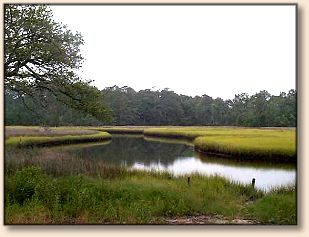
We fished for two more hours and then decided to call it
a day. I don't know what it is. Lee says it is the
cigars. Every time I go fishing with Lee we catch oodles
of fish. We haven't been skunked yet.
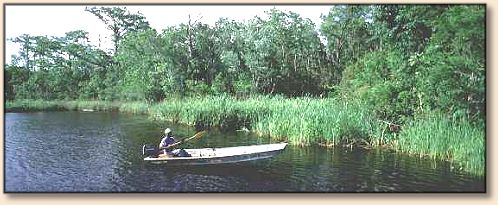
Next time you are in Eastern North Carolina, check the rivers
and creeks that form the back waters of our coastal environment.
You will be glad you did. ~ Doug
About Doug:
Capt Doug Sinclair is a saltwater fly-fishing guide,
casting instructor, writer and photographer from Alliance
(Oriental), North Carolina. You can find him on the web
at www.flyfishcarolina.com or call him at 252.617.5580.
|






 Sure had the right fly. Only trouble was we didn't have
more than 6 of these flies in the box. We moved up the
river to Starky's Creek to see if there were any larger
fish hanging out near the mouth. Lee positioned the boat.
I let out a nice cast under some low hanging branches and
the first strike was a 2 pound large mouth bass. Not
three minutes later Lee landed one. We stayed in that
general location for about two hours, each of us catching
and releasing more than 30 large mouth bass. All caught
on the same flies. This was great fun. Large mouth bass
pull hard and do a lot of tail walking, head shaking and
running before you ever get them to the boat.
Sure had the right fly. Only trouble was we didn't have
more than 6 of these flies in the box. We moved up the
river to Starky's Creek to see if there were any larger
fish hanging out near the mouth. Lee positioned the boat.
I let out a nice cast under some low hanging branches and
the first strike was a 2 pound large mouth bass. Not
three minutes later Lee landed one. We stayed in that
general location for about two hours, each of us catching
and releasing more than 30 large mouth bass. All caught
on the same flies. This was great fun. Large mouth bass
pull hard and do a lot of tail walking, head shaking and
running before you ever get them to the boat.